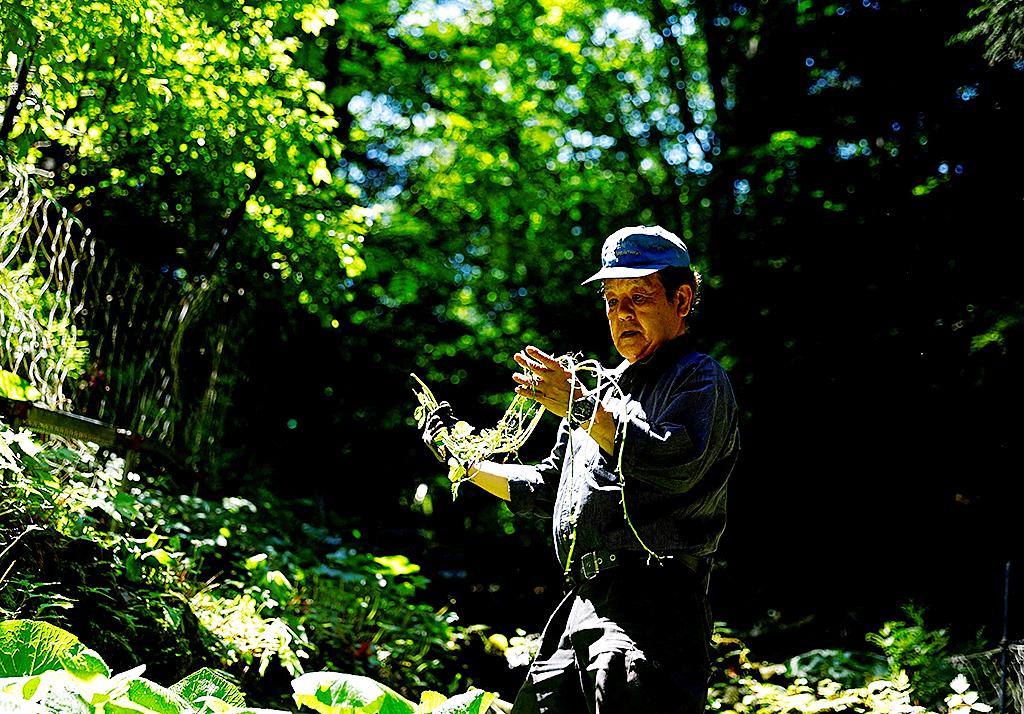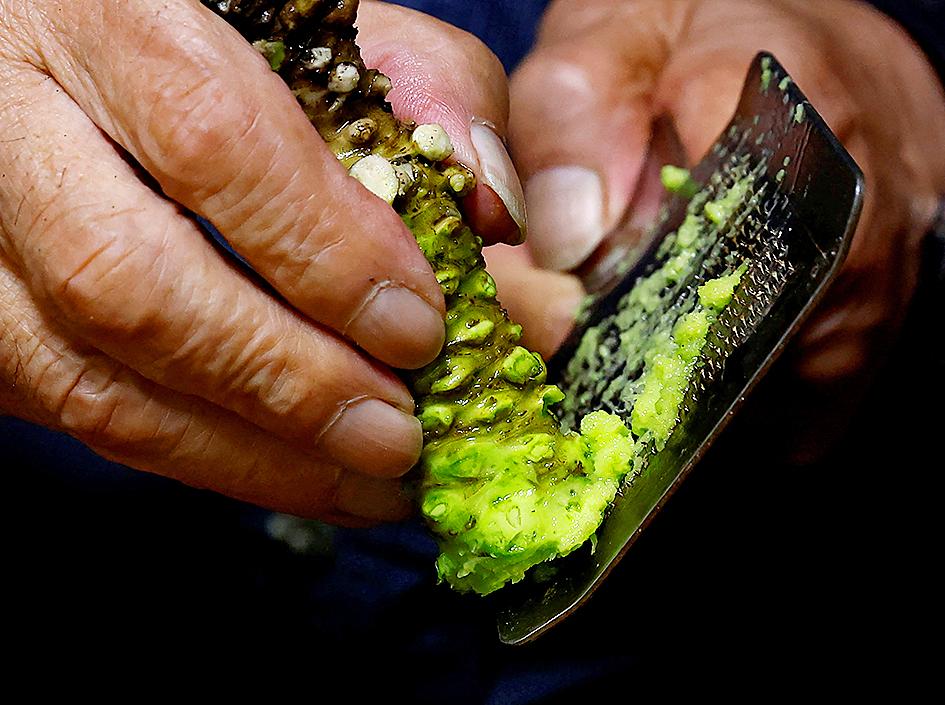Masahiro Hoshina, a Japanese farmer, starts worrying about typhoon season months before it begins, haunted by memories of the heavy rains and landslides that washed away wasabi farms during one 2019 storm.
“Recently the power of typhoons feels totally different from before due to global warming. It’s getting stronger,” said the 70-year-old farmer in Okutama, west of downtown Tokyo.
“Since it’s happened once, there’s no guarantee it won’t happen again.”

Photo: Reuters
Wasabi, the tangy Japanese horseradish that’s an essential part of sushi and dabbed onto slices of raw fish or into bowls of soba buckwheat noodle soup, is usually grown along streams in narrow valleys, leaving farms prone to disasters.
Typhoon Hagibis, which slammed into eastern Japan in 2019, slashed production in Okutama by nearly 70 percent the next year. The need for replanting and careful tending meant it’s taken nearly three years for sushi farms there to recover.
Experts say global warming is affecting production not only by increasing the number and severity of storms, but with rising temperatures that threaten growth of the plants, which need to be in water a consistent 10-15 degrees Celsius year-round.

Photo: Reuters
A lack of wasabi could also endanger traditional Japanese foods such as sushi and sashimi, where the tang of the wasabi is used as a contrast with raw fish.
Weather isn’t the only obstacle wasabi farmers face. A drop in rural populations due to aging means there are no successors. Because of the two factors, the output of wasabi grown in clear-flowing water, like at Hoshina’s farm, had fallen to half that of 2005, according to the Agriculture Ministry.
Norihito Onishi, head sales manager at a chain of soba buckwheat noodle restaurants called Sojibo, has seen his business directly affected by wasabi shortages and supply problems.
The restaurants were long known for allowing customers to grind their own wasabi roots to produce the spicy paste used as a condiment for soba. But they’ve had to mostly give this up.
“In the past, we served all the cold soba noodles with a piece of raw wasabi, but now we can no longer do that,” Onishi said.
Though wasabi root was plentiful when the restaurant first opened 30 years ago, Onishi said over the last 5 to 10 years there have been times when he couldn’t get any at all. The precious root is now made available only for certain types of dishes.
“If this unstable supply of wasabi persists, due to many factors including global warming, we will face a situation where we need to come up with other ways to overcome the problem so we don’t end up not serving raw wasabi at all,” said Onishi.

Exceptions to the rule are sometimes revealing. For a brief few years, there was an emerging ideological split between the Democratic Progressive Party (DPP) and Chinese Nationalist Party (KMT) that appeared to be pushing the DPP in a direction that would be considered more liberal, and the KMT more conservative. In the previous column, “The KMT-DPP’s bureaucrat-led developmental state” (Dec. 11, page 12), we examined how Taiwan’s democratic system developed, and how both the two main parties largely accepted a similar consensus on how Taiwan should be run domestically and did not split along the left-right lines more familiar in

As I finally slid into the warm embrace of the hot, clifftop pool, it was a serene moment of reflection. The sound of the river reflected off the cave walls, the white of our camping lights reflected off the dark, shimmering surface of the water, and I reflected on how fortunate I was to be here. After all, the beautiful walk through narrow canyons that had brought us here had been inaccessible for five years — and will be again soon. The day had started at the Huisun Forest Area (惠蓀林場), at the end of Nantou County Route 80, north and east

Specialty sandwiches loaded with the contents of an entire charcuterie board, overflowing with sauces, creams and all manner of creative add-ons, is perhaps one of the biggest global food trends of this year. From London to New York, lines form down the block for mortadella, burrata, pistachio and more stuffed between slices of fresh sourdough, rye or focaccia. To try the trend in Taipei, Munchies Mafia is for sure the spot — could this be the best sandwich in town? Carlos from Spain and Sergio from Mexico opened this spot just seven months ago. The two met working in the

This month the government ordered a one-year block of Xiaohongshu (小紅書) or Rednote, a Chinese social media platform with more than 3 million users in Taiwan. The government pointed to widespread fraud activity on the platform, along with cybersecurity failures. Officials said that they had reached out to the company and asked it to change. However, they received no response. The pro-China parties, the Chinese Nationalist Party (KMT) and Taiwan People’s Party (TPP), immediately swung into action, denouncing the ban as an attack on free speech. This “free speech” claim was then echoed by the People’s Republic of China (PRC),